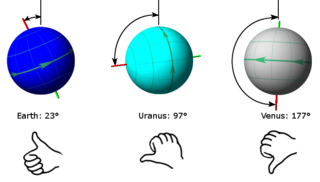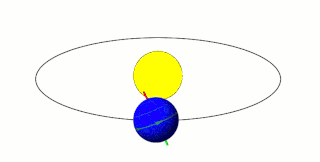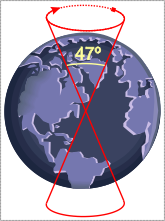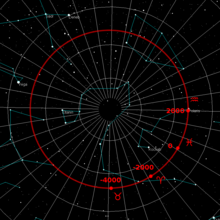
The ecliptic or ecliptic plane is the orbital plane of Earth around the Sun. From the perspective of an observer on Earth, the Sun's movement around the celestial sphere over the course of a year traces out a path along the ecliptic against the background of stars. The ecliptic is an important reference plane and is the basis of the ecliptic coordinate system.

Hipparchus was a Greek astronomer, geographer, and mathematician. He is considered the founder of trigonometry, but is most famous for his incidental discovery of the precession of the equinoxes. Hipparchus was born in Nicaea, Bithynia, and probably died on the island of Rhodes, Greece. He is known to have been a working astronomer between 162 and 127 BC.

Precession is a change in the orientation of the rotational axis of a rotating body. In an appropriate reference frame it can be defined as a change in the first Euler angle, whereas the third Euler angle defines the rotation itself. In other words, if the axis of rotation of a body is itself rotating about a second axis, that body is said to be precessing about the second axis. A motion in which the second Euler angle changes is called nutation. In physics, there are two types of precession: torque-free and torque-induced.

Right ascension is the angular distance of a particular point measured eastward along the celestial equator from the Sun at the March equinox to the point in question above the Earth. When paired with declination, these astronomical coordinates specify the location of a point on the celestial sphere in the equatorial coordinate system.

The zodiac is a belt-shaped region of the sky that extends approximately 8° north and south of the ecliptic, which is the apparent path of the Sun across the celestial sphere over the course of the year. The orbital paths of the Moon and major planets are within the belt of the zodiac.
A sidereal year, also called a sidereal orbital period, is the time that Earth or another planetary body takes to orbit the Sun once with respect to the fixed stars.

In astronomy, axial precession is a gravity-induced, slow, and continuous change in the orientation of an astronomical body's rotational axis. In the absence of precession, the astronomical body's orbit would show axial parallelism. In particular, axial precession can refer to the gradual shift in the orientation of Earth's axis of rotation in a cycle of approximately 26,000 years. This is similar to the precession of a spinning top, with the axis tracing out a pair of cones joined at their apices. The term "precession" typically refers only to this largest part of the motion; other changes in the alignment of Earth's axis—nutation and polar motion—are much smaller in magnitude.

In astronomy, axial tilt, also known as obliquity, is the angle between an object's rotational axis and its orbital axis, which is the line perpendicular to its orbital plane; equivalently, it is the angle between its equatorial plane and orbital plane. It differs from orbital inclination.

The Almagest is a 2nd-century mathematical and astronomical treatise on the apparent motions of the stars and planetary paths, written by Claudius Ptolemy in Koine Greek. One of the most influential scientific texts in history, it canonized a geocentric model of the Universe that was accepted for more than 1,200 years from its origin in Hellenistic Alexandria, in the medieval Byzantine and Islamic worlds, and in Western Europe through the Middle Ages and early Renaissance until Copernicus. It is also a key source of information about ancient Greek astronomy.

The first point of Aries, also known as the cusp of Aries, is the location of the vernal equinox, used as a reference point in celestial coordinate systems. In diagrams using such coordinate systems, it is often indicated with the symbol ♈︎. Named for the constellation of Aries, it is one of the two points on the celestial sphere at which the celestial equator crosses the ecliptic, the other being the first point of Libra, located exactly 180° from it. Due to precession of the equinoxes since the positions were originally named in antiquity, the position of the Sun when at the vernal equinox is now in Pisces; when it is at the Autumnal equinox, it is in Virgo.

Lunar precession is a term used for three different precession motions related to the Moon. First, it can refer to change in orientation of the lunar rotational axis with respect to a reference plane, following the normal rules of precession followed by spinning objects. In addition, the orbit of the Moon undergoes two important types of precessional motion: apsidal and nodal.

The Age of Aquarius, in astrology, is either the current or forthcoming astrological age, depending on the method of calculation. Astrologers maintain that an astrological age is a product of the Earth's slow precessional rotation and lasts for 2,160 years, on average.

An astrological age is a time period in astrological theory which astrologers say, parallels major changes in the development of Earth's inhabitants, particularly relating to culture, society, and politics. There are twelve astrological ages corresponding to the twelve zodiacal signs in western astrology. Advocates believe that when one cycle of the twelve astrological ages, called a Great Year, is completed, another cycle of twelve ages begins. The length of one cycle of twelve ages is 25,772 years.
Trepidation, in now-obsolete medieval theories of astronomy, refers to hypothetical oscillation in the precession of the equinoxes. The theory was popular from the 9th to the 16th centuries.
A lunar standstill or lunistice is when the Moon reaches its furthest north or furthest south point during the course of a month. The declination at lunar standstill varies in a cycle 18.6 years long between 18.134° and 28.725°, due to lunar precession. These extremes are called the minor and major lunar standstills.
Precession refers to a specific change in the direction of the rotation axis of a rotating object, in which the second Euler angle is constant

Earth-centered inertial (ECI) coordinate frames have their origins at the center of mass of Earth and are fixed with respect to the stars. "I" in "ECI" stands for inertial, in contrast to the "Earth-centered – Earth-fixed" (ECEF) frames, which remains fixed with respect to Earth's surface in its rotation, and then rotates with respect to stars.

In celestial mechanics, apsidal precession is the precession of the line connecting the apsides of an astronomical body's orbit. The apsides are the orbital points farthest (apoapsis) and closest (periapsis) from its primary body. The apsidal precession is the first time derivative of the argument of periapsis, one of the six main orbital elements of an orbit. Apsidal precession is considered positive when the orbit's axis rotates in the same direction as the orbital motion. An apsidal period is the time interval required for an orbit to precess through 360°, which takes Earth's orbit about 112,000 years, completing a cycle and returning to the same orientation.
A tropical year or solar year is the time that the Sun takes to return to the same position in the sky of a celestial body of the Solar System such as the Earth, completing a full cycle of seasons; for example, the time from vernal equinox to vernal equinox, or from summer solstice to summer solstice. It is the type of year used by tropical solar calendars. The solar year is one type of astronomical year and particular orbital period. Another type is the sidereal year, which is the time it takes Earth to complete one full orbit around the Sun as measured with respect to the fixed stars, resulting in a duration of 20 minutes longer than the tropical year, because of the precession of the equinoxes.

Axial parallelism is the characteristic of a rotating body in which the direction of the axis of rotation remains fixed as the object moves through space. In astronomy, this characteristic is found in astronomical bodies in orbit. It is the same effect that causes a gyroscope's axis of rotation to remain constant as Earth rotates, allowing the devices to measure Earth's rotation.

















